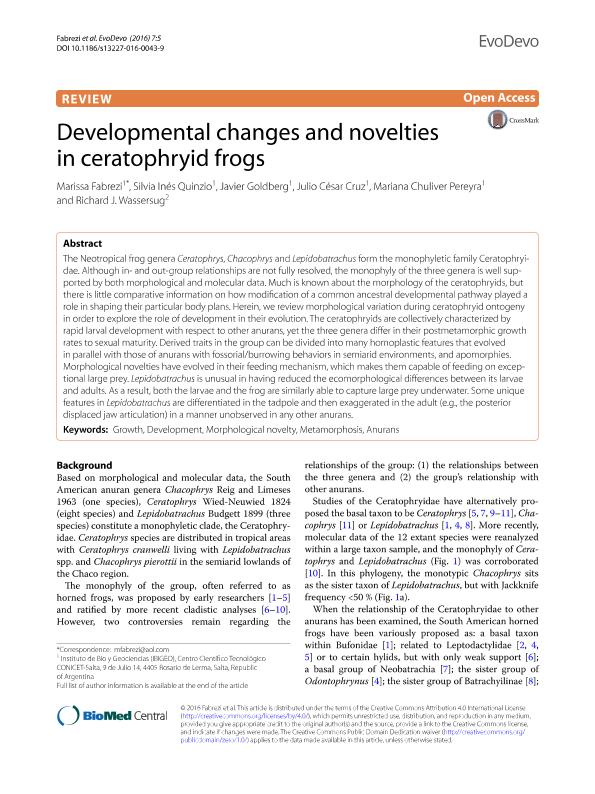Artículo
Developmental changes and novelties in ceratophryid frogs
Fabrezi, Marissa ; Quinzio, Silvia Inés
; Quinzio, Silvia Inés ; Goldberg, Francisco Javier
; Goldberg, Francisco Javier ; Cruz, Julio Cesar
; Cruz, Julio Cesar ; Chuliver Pereyra, Mariana
; Chuliver Pereyra, Mariana ; Wassersug, Richard J.
; Wassersug, Richard J.
 ; Quinzio, Silvia Inés
; Quinzio, Silvia Inés ; Goldberg, Francisco Javier
; Goldberg, Francisco Javier ; Cruz, Julio Cesar
; Cruz, Julio Cesar ; Chuliver Pereyra, Mariana
; Chuliver Pereyra, Mariana ; Wassersug, Richard J.
; Wassersug, Richard J.
Fecha de publicación:
02/2016
Editorial:
BioMed Central
Revista:
EvoDevo
e-ISSN:
2041-9139
Idioma:
Inglés
Tipo de recurso:
Artículo publicado
Clasificación temática:
Resumen
The Neotropical frog genera Ceratophrys, Chacophrys and Lepidobatrachus form the monophyletic family Ceratophryidae. Although in- and out-group relationships are not fully resolved, the monophyly of the three genera is well supported by both morphological and molecular data. Much is known about the morphology of the ceratophryids, but there is little comparative information on how modification of a common ancestral developmental pathway played a role in shaping their particular body plans. Herein, we review morphological variation during ceratophryid ontogeny in order to explore the role of development in their evolution. The ceratophryids are collectively characterized by rapid larval development with respect to other anurans, yet the three genera differ in their postmetamorphic growth rates to sexual maturity. Derived traits in the group can be divided into many homoplastic features that evolved in parallel with those of anurans with fossorial/burrowing behaviors in semiarid environments, and apomorphies. Morphological novelties have evolved in their feeding mechanism, which makes them capable of feeding on exceptional large prey. Lepidobatrachus is unusual in having reduced the ecomorphological differences between its larvae and adults. As a result, both the larvae and the frog are similarly able to capture large prey underwater. Some unique features in Lepidobatrachus are differentiated in the tadpole and then exaggerated in the adult (e.g., the posterior displaced jaw articulation) in a manner unobserved in any other anurans.
Palabras clave:
Growth
,
Development
,
Morphological Novelty
,
Metamorphosis
,
Anurans
Archivos asociados
Licencia
Identificadores
Colecciones
Articulos(IBIGEO)
Articulos de INST.DE BIO Y GEOCIENCIAS DEL NOA
Articulos de INST.DE BIO Y GEOCIENCIAS DEL NOA
Citación
Fabrezi, Marissa; Quinzio, Silvia Inés; Goldberg, Francisco Javier; Cruz, Julio Cesar; Chuliver Pereyra, Mariana; et al.; Developmental changes and novelties in ceratophryid frogs; BioMed Central; EvoDevo; 7; 5; 2-2016; 1-16
Compartir
Altmétricas



